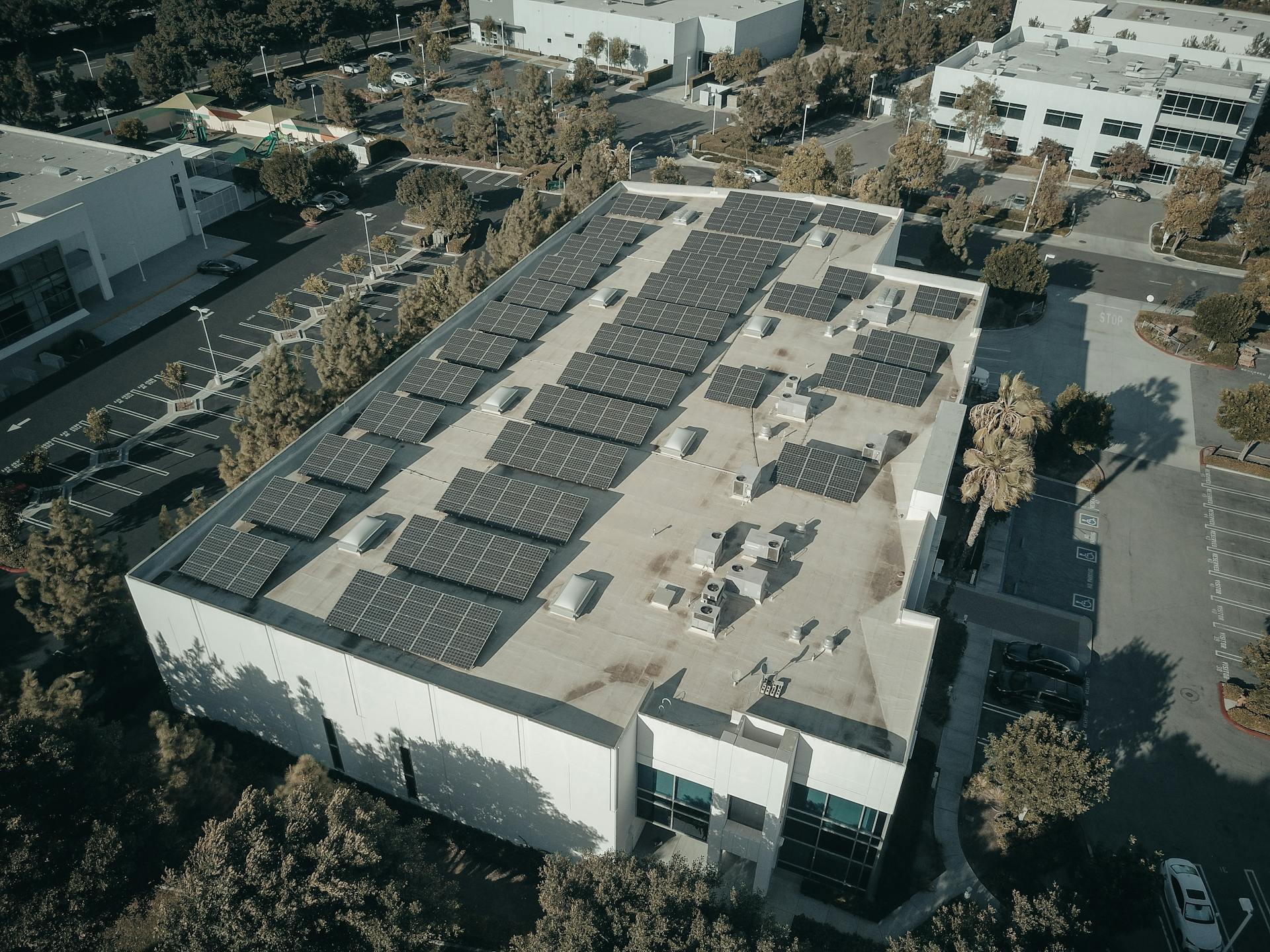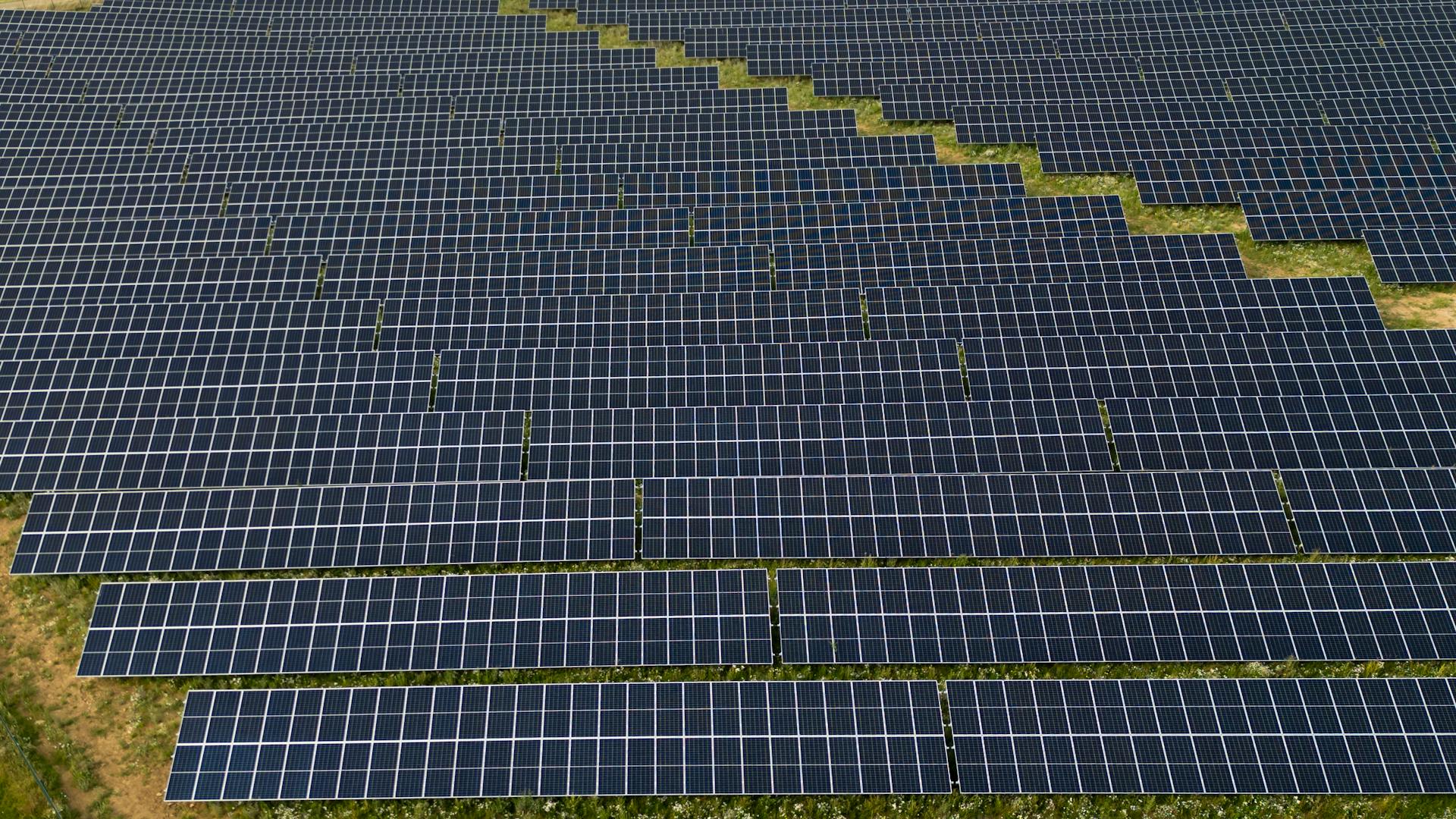
Commercial solar loans can help businesses cover the upfront costs of installing solar panels, making it a viable option for those seeking to reduce their energy expenses.
These loans can be tailored to fit a business's specific financial situation, with loan terms ranging from 5 to 20 years.
Businesses can choose from various loan types, including fixed-rate loans and variable-rate loans, each with its own advantages and disadvantages.
A fixed-rate loan provides predictable monthly payments, while a variable-rate loan may offer lower interest rates but with the risk of increasing payments over time.
Check this out: Current Prime Rate for Commercial Loans
Commercial Solar Loan Options
Commercial solar loans allow building owners to take advantage of tax credits and depreciation, delivering lower energy costs and increased Net Operating Income. This type of financing allows businesses to borrow capital for the solar system and installation, paying it back over time with interest.
There are several types of commercial solar loan options available. A non-recourse solar loan, for example, can be up to 20 years with a starting interest rate of 4% - 5%. This type of loan is fully amortized and has no prepayment penalty.
Suggestion: Commercial Loans Interest Rates History Chart
The benefits of a commercial solar loan include lower energy costs and increased Net Operating Income. With a commercial solar loan, businesses can save up to 30% on their electric expenses every month, which is an infinite return on investment if there is no money out of pocket.
Here are some common commercial solar loan options:
- Solar Loans: borrow money from a lender to buy and install solar panels, taking advantage of tax credits and net operating income.
- Solar Leases: pay a monthly fee to a lender for use of the solar panels, with the option to own them at the end of the lease term.
- Power Purchase Agreements: pay for the power you need, without owning the solar panels.
It's worth noting that commercial solar loans can be structured to minimize upfront costs. Some lenders offer financing options with little to no upfront costs, allowing businesses to save money on their electricity bills from day one.
Broaden your view: Pay Car Lease Upfront
Benefits and Incentives
With a commercial solar loan, you'll not only save money on your electricity bills, but you'll also have the opportunity to own the solar system and apply for tax credits and incentives. This can result in a 120% return of equity through tax credits and accelerated depreciation.
The federal solar investment tax credit (ITC) is still available for residential and commercial PV solar installations, with a 26% tax credit on the total cost of the parts and installation for systems that commence construction between now and 2022. This percentage will drop down to 22% in 2023, and then to 10% for commercial customers in 2024.
Explore further: Mosaic Solar Loan Rates
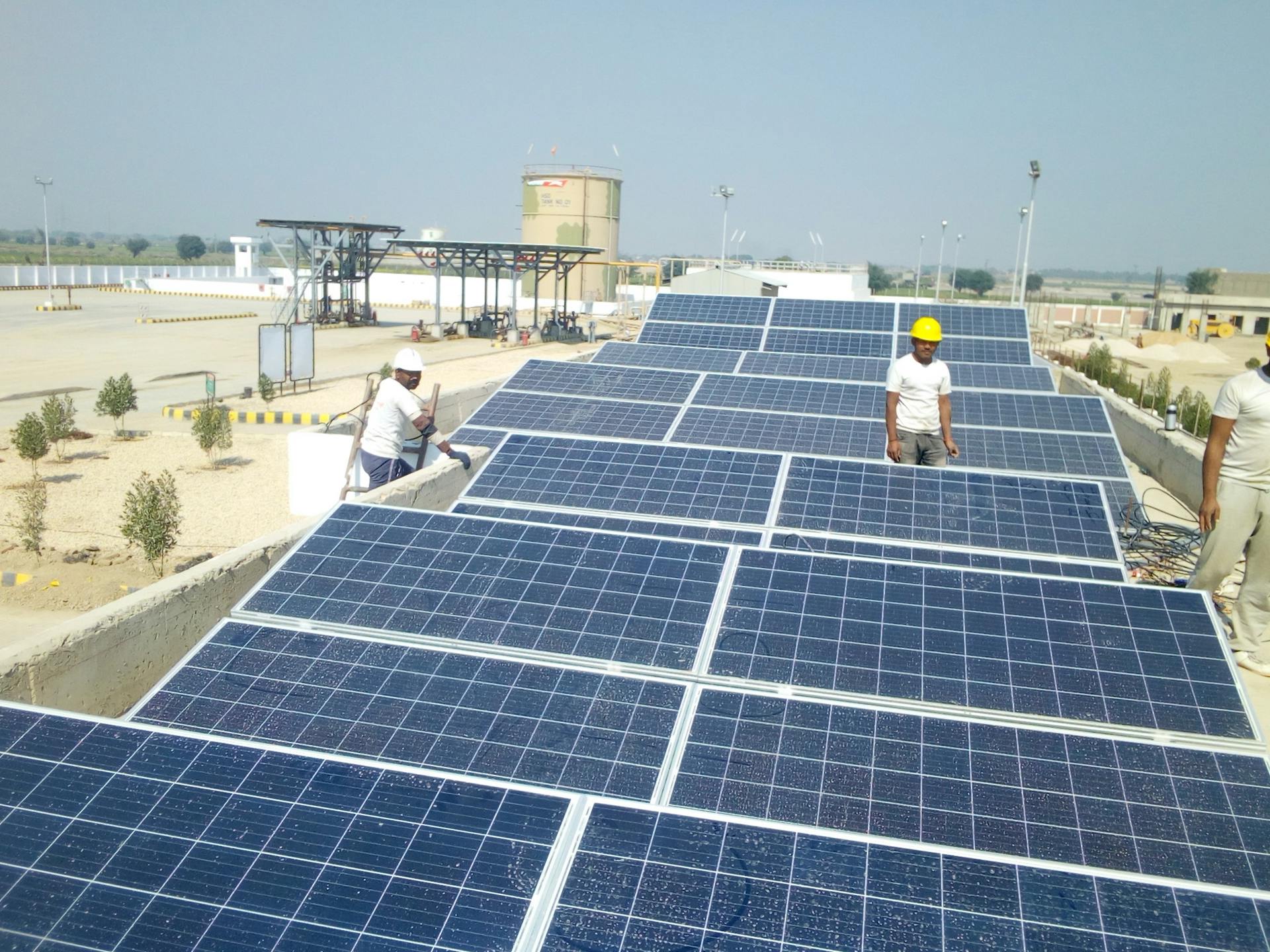
You can also save on taxes with a commercial solar loan, thanks to the Investment Tax Credit (ITC) and accelerated depreciation through the Modified Accelerated Cost Recovery System (MACRS). This can result in a significant reduction of your tax liability.
Here are some state-specific incentives and rebates you may be eligible for:
- Massachusetts: Renewable Energy Property Tax Exemption, Solar Massachusetts Renewable Target (SMART) Program, Renewable Energy Equipment Sales Tax Exemption
- Rhode Island: Clean Energy Grant Incentive Program, The Solarize Rhode Island Program, Weatherization Assistance Program (WAP), The Renewable Energy Growth Program (REG), The Renewable Energy Fund (REF), Property Tax Exemption, and more.
- Connecticut: Property Tax Exemption, Sales and Use Tax Exemption, Connecticut Green Bank Solar Initiatives, Zero-emission Renewable Energy Credits (ZREC), Shared Clean Energy Facility Program (SCEF)
- New Hampshire: 100% First Year Bonus Depreciation, Property Tax Exemption, New Hampshire Public Utilities Commission (PUC) Rebates, Sales Tax Exemption
- Vermont: Vermont State Investment Tax Credit (ITC), Renewable Energy Credits (RECs), The Commercial Energy Loan Program (CELP), Sales Tax Exemption
- New York: Property Tax Exemption, New York City Property Tax Abatement (PTA), NY-Sun Incentive, Sales Tax Exemption
Benefits and Incentives
If you're considering investing in a commercial solar energy system, you're probably wondering about the benefits and incentives. One of the biggest perks is that you can save money on your electricity bills, with some estimates suggesting that big-box stores in the US could collectively save $8.2 billion annually if they installed solar.
You can also save on taxes through the Investment Tax Credit (ITC), which allows you to receive a federal tax credit for 30% of the system cost. This credit will last until 2019, after which it will incrementally decrease through 2021.
A solar power purchase agreement can help you save money on energy bills and increase your net operating income. You'll also purchase only the energy you use, with no waste.
Readers also liked: Banks That Will Refinance Upside down Car Loans
The cost of producing solar energy stays largely constant over time, so by investing in a PV system, you can protect yourself from hikes in electricity costs. Commercial utility rates increased an average of 2.4% per year between 2000 and 2015, but the cost of solar energy remains stable.
You can also take advantage of state-specific incentives, such as the Solar Massachusetts Renewable Target (SMART) Program in Massachusetts, which offers a number of benefits to commercial solar customers. Some of these benefits include:
- Renewable Energy Property Tax Exemption
- Solar Massachusetts Renewable Target (SMART) Program
- Renewable Energy Equipment Sales Tax Exemption
Additionally, you may be eligible for investment depreciation under the Modified Accelerated Cost Recovery System (MACRS), which allows you to recover some of the costs of the solar energy system as it depreciates over time.
PPA Benefits
A PPA, or Power Purchase Agreement, offers numerous benefits to landowners and businesses. By installing a commercial solar energy system through a PPA, you can purchase the power generated onsite at a rate less than the electric utility's.
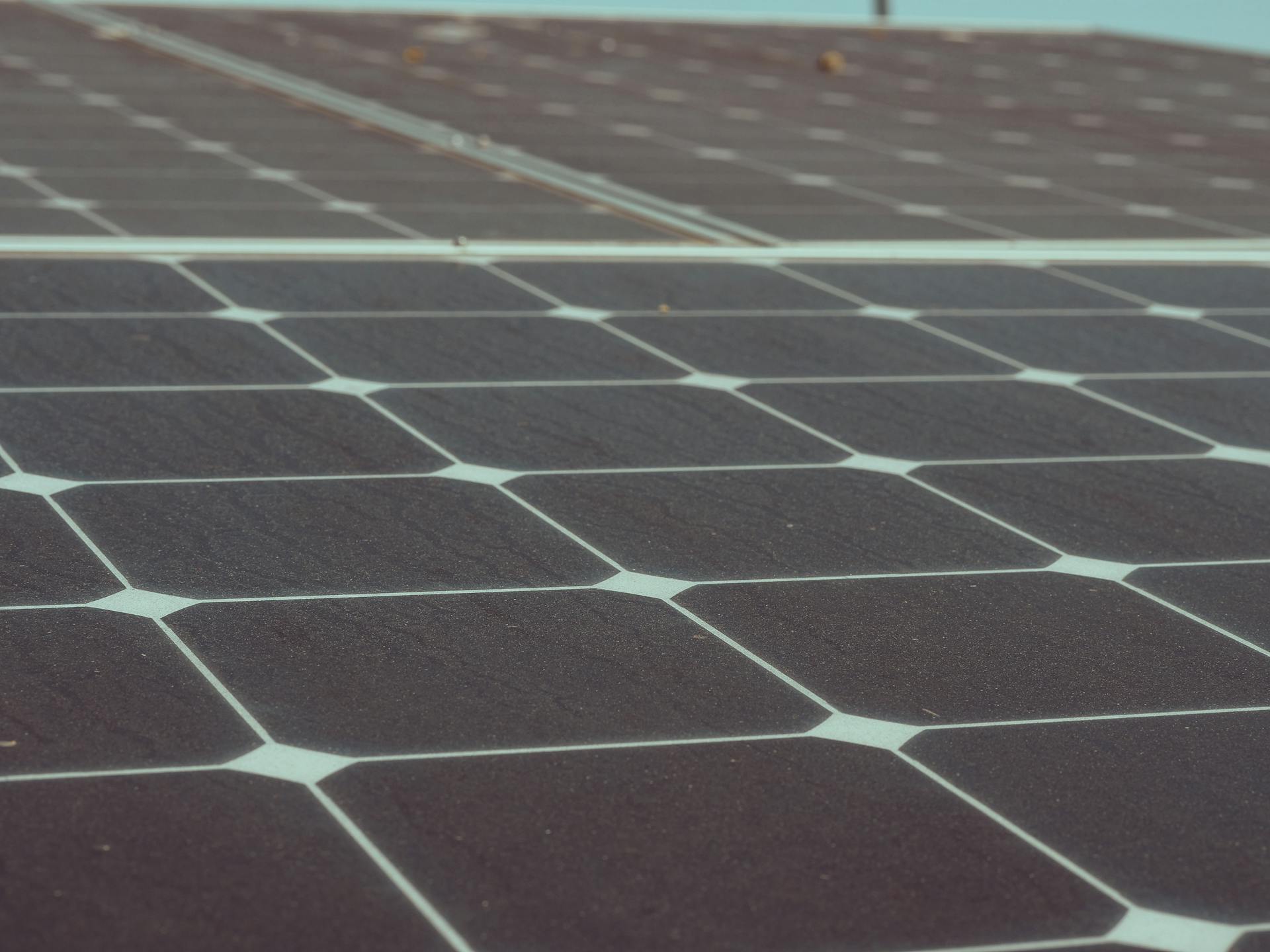
One of the biggest advantages of a PPA is that it can save you money on energy bills. According to industry experts, PPAs can increase net operating income, making them a smart financial move for commercial and industrial sectors.
In a PPA, you can purchase only the energy you use, eliminating waste and reducing your carbon footprint. This is especially beneficial for organizations that don't have high tax bills, as they can indirectly benefit from another entity taking tax incentives on their behalf.
Here are some key benefits of a PPA at a glance:
- Save money on energy bills
- Increase net operating income
- Purchase only the energy you use, no waste
PPAs can also be structured to require no upfront payment, making them a more accessible option for businesses and landowners. Additionally, the long-term nature of some PPAs can allow for lower payments over time.
Leasing and Financing
Commercial solar leases allow building owners to lower energy costs and increase net operating income without immediate ownership, with the option to obtain ownership at the end of the lease term.
Suggestion: Does Reg B Apply to Commercial Loans
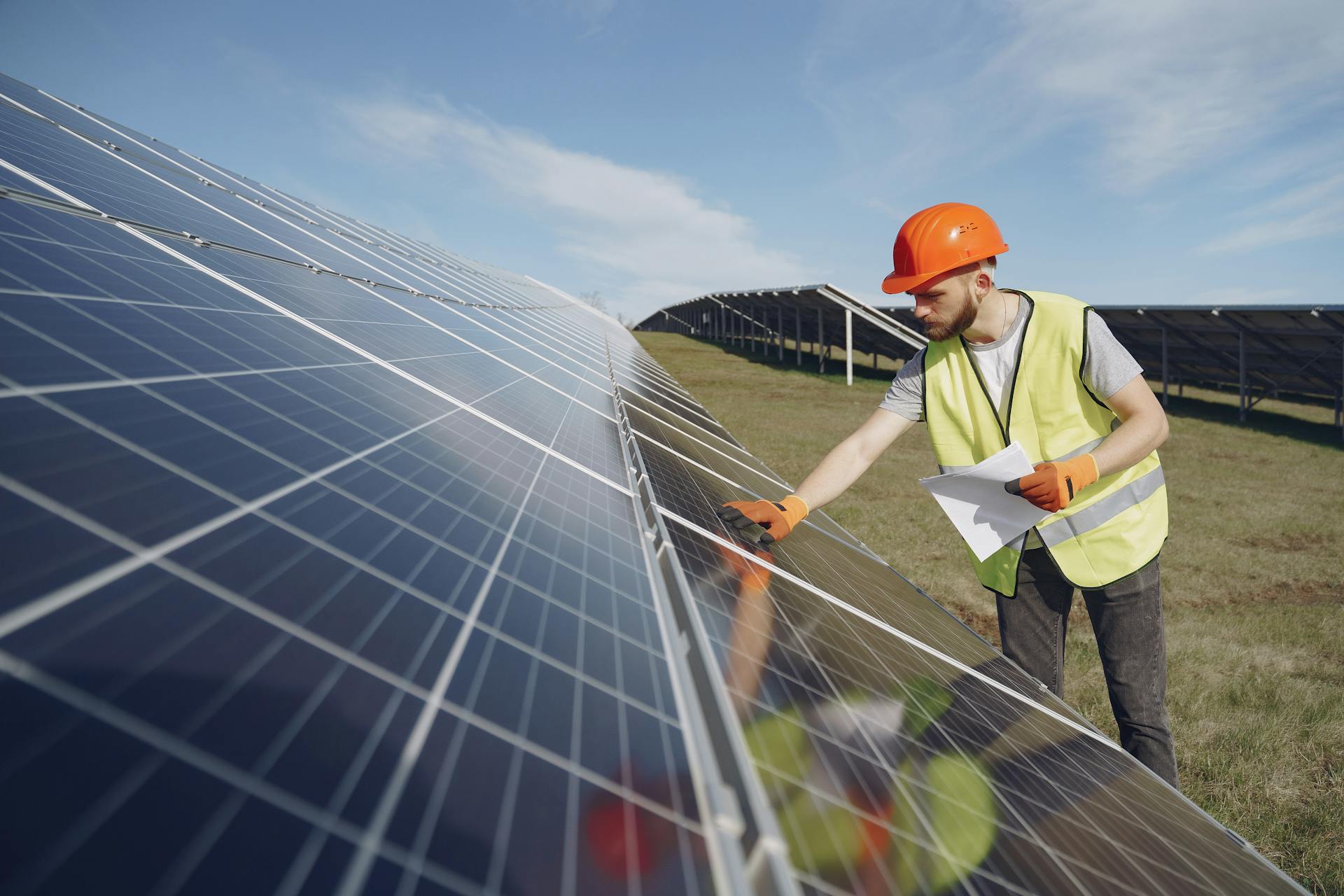
Leases are a common way of financing commercial solar properties, where a third-party financier owns the PV system and the customer pays a fixed rate over a set number of years.
Solar leases provide consistency and the ability to plan costs, but if production is lower than anticipated, the customer's bill will not be proportionally reduced.
A solar lease charges a fixed fee to the building owner every month for using the system, and the lessor maintains the system over the duration of the contract.
The fixed nature of lease payments means they do not include escalators as many PPAs do.
Here are some key differences between PPAs and leases:
Leases can be a great option for building owners who want to reduce their energy costs and increase their net operating income, but it's essential to carefully review the terms and conditions before signing a lease agreement.
Solutions
Sunwest Bank offers full-service renewable energy financing for commercial buildings across the U.S., with offices in California, Arizona, Idaho, Utah, and Florida.
You can get a preliminary financing quote for a solar energy system by sending a message to Sunwest Bank, and they'll generate a quote that shows the potential return on investment.
Some commercial mortgage lenders are now accepting the principles of solar financing, and HUD offers 30 and 40-year commercial mortgages that incorporate the cost of solar energy systems.
CPACE financing is a popular option for commercial solar energy installations, offering 100% financing with no out-of-pocket expenses and long-term financing up to 25 years.
Here are some benefits of CPACE financing:
- 100% Financing
- No Out-Of-Pocket Expenses
- Long-Term Financing (Up to 25 Years)
- Lower Energy Costs
- Cash Flow Positive Projects
- No Personal Guarantees
- Competitive Rates and Terms
- Owner Retains All Tax Incentives
- Combine with Utility Incentives
- Automatic Transfer Upon Sale
- Preserves Capital for Core Business
ESA (Energy Service Agreement) is another option, similar to a PPA, and is suitable for Governmental and Non-Profit entities.
Leases
Leases are a common way to finance commercial solar properties, similar to Power Purchase Agreements (PPAs).
They allow building owners to lower energy costs and increase net operating income without immediate ownership. The lessor maintains the system over the duration of the contract and charges a fixed fee to the building owner every month.
This fixed fee is not directly tied to system production, so if production is lower than anticipated, the customer's bill won't be proportionally reduced. On the other hand, this provides consistency and the ability to plan costs.
There are two types of solar leases: operating leases and capital leases. Operating leases are not held on the balance sheet of the company, while capital leases are.
The length of a solar lease can vary widely, from as few as seven years to as many as 25. However, commercial solar leases are often shorter than commercial solar PPAs, typically falling into the 7-10 year term length category.
If you only have seven or 10 years to amortize those payments, those payments are going to be considerably higher than a longer-term agreement.
For your interest: Short Term Bridge Loan Rates
Partnership Flips
A partnership flip is a type of tax equity financing in solar where the tax equity investor receives 99% of the project's income allocation until the ITC recapture period has elapsed.
The tax equity investor's goal is to monetize virtually all of the tax benefits, not to own the asset for the long term. They aim to be a partner in the deal until the benefits of the tax equity have been monetized.
After the ITC recapture period has elapsed, the tax equity investor's allocation "flips" to a minority share, typically 1%, and the project sponsor takes over the majority share, usually 99%. This allows the sponsor to retain the asset for the long haul.
The tax equity investor's goal is not to own the asset, but to monetize the tax benefits, which is why they "flip" out of the deal once their benefits have been realized.
You might like: How Long Are Commercial Real Estate Loans
Sources
- https://www.sunwestbank.com/solar/
- https://aurorasolar.com/blog/how-to-pay-for-commercial-solar-a-financing-guide-for-contractors/
- https://sunrenu.com/commercial-solar/commercial-solar-financing/
- https://www.popeenergy.com/financing-solar-projects/
- https://aurorasolar.com/blog/commercial-solar-financing-three-bottom-line-benefits-to-going-solar/
Featured Images: pexels.com
